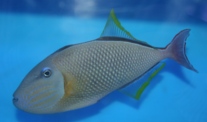Hello, Frank Indiviglio here.
Anchor worms are crustaceans (specifically copepods) and as such are more closely related to shrimp than to worms. They often make their presence known in outdoor ponds as winter turns to spring. Lernaea elegans, the most commonly encountered species, remains dormant during the winter and becomes active as the water reaches 55 F or so.
Identification
Anchor worms bury below their host’s scales, but betray their presence by trailing ¼ to ½ inch-long portions of their black, thread-like bodies from infected fishes. They usually attach about a fish’s gills, eyes or fins, but can occur most anywhere. Other signs include inflamed or raised scales and efforts by fishes to dislodge the parasites (leaping, rubbing).
Infestations most commonly occur during the spring, when the parasites are searching for new hosts after their winter dormancy. Conveniently for the anchor worms, the immune systems of pond fishes are at their weakest at this time, having been stressed by cool temperatures and the long winter fast.
Secondary Bacterial Infections
Anchor worms rarely cause fatalities, but the wounds they inflict frequently become infected by opportunistic Pseudomonas and Aeromonas bacteria. Ever present in the pond, these pathogens can easily kill fishes, especially those with depressed immune systems.
Avoiding Anchor Worms
 Be especially careful to check for anchor worms when purchasing koi or goldfishes in the late winter or spring…those that have been wintered outdoors may be infected. They also parasitize weather fishes, channel catfishes, hi-fin loaches and other species commonly kept in outdoor ponds.
Be especially careful to check for anchor worms when purchasing koi or goldfishes in the late winter or spring…those that have been wintered outdoors may be infected. They also parasitize weather fishes, channel catfishes, hi-fin loaches and other species commonly kept in outdoor ponds.
Anchor worms of various species can also be introduced to your collection via tropical fishes which have been raised outdoors.
Treating Parasitized Fishes
Fortunately, Jungle Lab’s Anchors Away is an effective treatment for infestations of anchor worms and certain other parasites. Be aware that this medication will kill crayfishes, snails and other invertebrates, and that carbon should be removed from your filter while treatment is ongoing.
It is also useful to add an ultraviolet sterilizer to your pond’s filtration system. UV sterilizers will kill anchor worms in the free swimming larval stage (they are not effective against adults), thereby preventing re-infestation.
Further Reading
A detailed article (Food and Agriculture Association of the United Nations) on the life cycle of anchor worms and related parasitic copepods is posted at.
Please write in with your questions and comments. Thanks, until next time, Frank Indiviglio.
Image referenced from Wikipedia and originally posted by Brian Gratwicke
 On the salty side you’ll find our biggest excitement for the week, a male Crosshatch Trigger. He’s big, bold and beautiful. We also got a lovely little Yellow Assessor, who’s not to shy and would look terrific in someone’s reef! Other items of note are a small Watanabei Angel and two new damsels, Limbaugh’s and some big Scissortail Chromis.
On the salty side you’ll find our biggest excitement for the week, a male Crosshatch Trigger. He’s big, bold and beautiful. We also got a lovely little Yellow Assessor, who’s not to shy and would look terrific in someone’s reef! Other items of note are a small Watanabei Angel and two new damsels, Limbaugh’s and some big Scissortail Chromis. Not too much fresh on the freshwater end this week, but there are the Swamp Eels that might be very interesting in the right tank. Also some nice looking Albino Butterfly Bristlenose Plecos. There are also some other fish for communities that don’t come around too often including Inky Barbs, Burma Danios, and Empire Gudgeons.
Not too much fresh on the freshwater end this week, but there are the Swamp Eels that might be very interesting in the right tank. Also some nice looking Albino Butterfly Bristlenose Plecos. There are also some other fish for communities that don’t come around too often including Inky Barbs, Burma Danios, and Empire Gudgeons. That Fish Blog – Aquarium Advice and Information
That Fish Blog – Aquarium Advice and Information

 Also known as the Tailbar Cichlid, this particular species hails from the rivers of Central America. It frequents areas of still or slow moving waters , hiding amongst root tangles. An uncommon fish in the hobby, we have been carrying 2″ juveniles for a little while now, along with a beautiful 6″ male in a separate aquarium that also arrived.
Also known as the Tailbar Cichlid, this particular species hails from the rivers of Central America. It frequents areas of still or slow moving waters , hiding amongst root tangles. An uncommon fish in the hobby, we have been carrying 2″ juveniles for a little while now, along with a beautiful 6″ male in a separate aquarium that also arrived. Be especially careful to check for anchor worms when purchasing koi or goldfishes in the late winter or spring…those that have been wintered outdoors may be infected. They also parasitize weather fishes, channel catfishes, hi-fin loaches and other species commonly kept in outdoor ponds.
Be especially careful to check for anchor worms when purchasing koi or goldfishes in the late winter or spring…those that have been wintered outdoors may be infected. They also parasitize weather fishes, channel catfishes, hi-fin loaches and other species commonly kept in outdoor ponds.